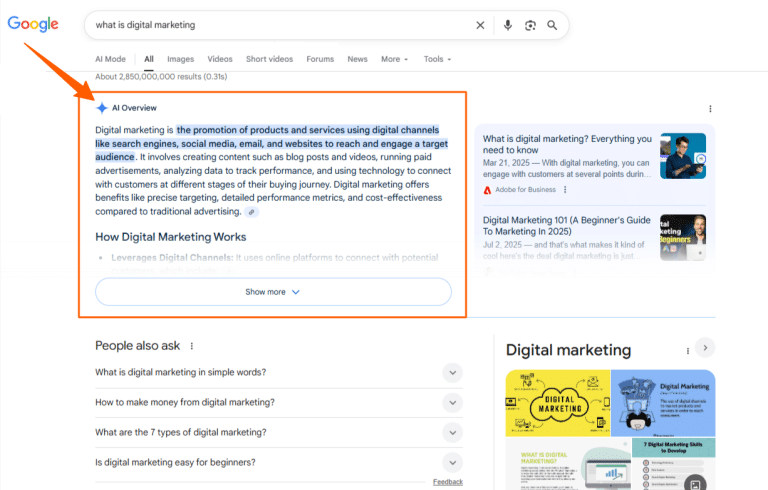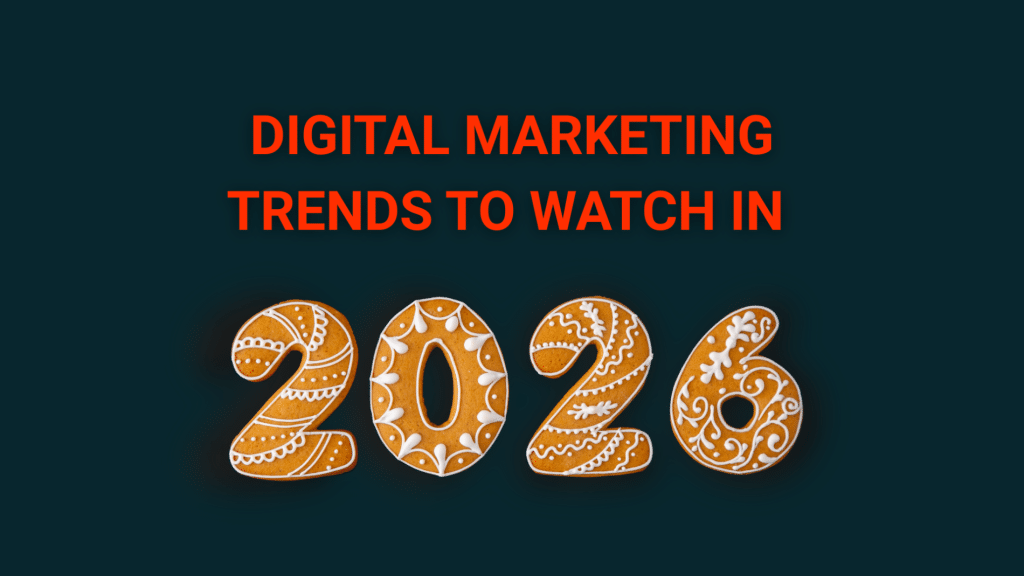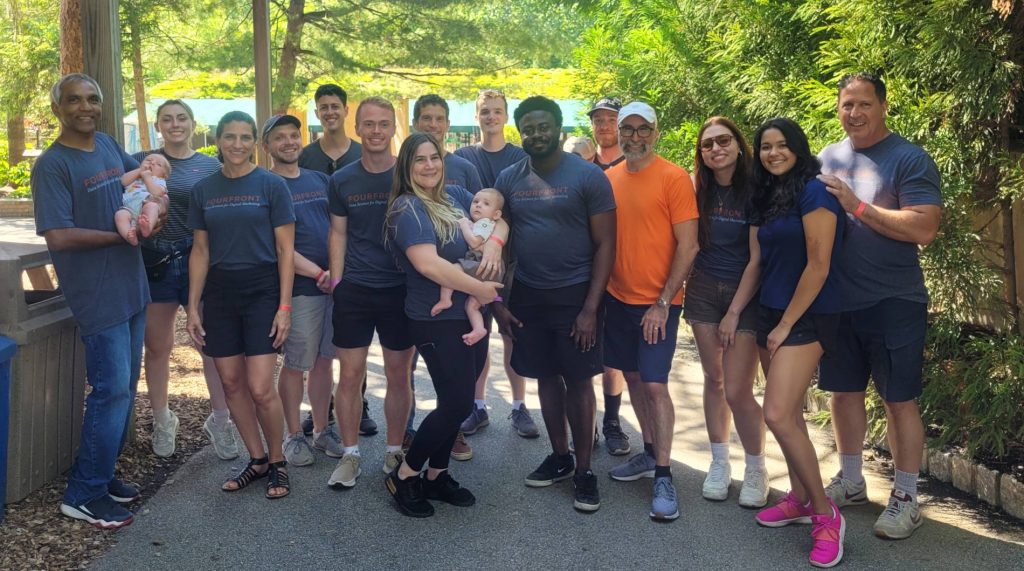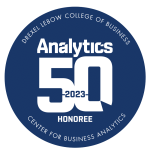Digital marketing, as always is changing – and changing fast. 2026 will bring significant changes to marketing strategies as technology advances and audience expectations evolve.
AI platforms are drastically changing audience behaviors, and brands will have to be quick to adapt to deliver authentic, engaging experiences that are measured not by vanity metrics, but by true audience engagement.
So what marketing trends can you expect in 2026? Let’s dive in.
TL;DR Summary
• Human-first content will reign supreme as marketers, audiences flock to AI platforms and processes.
• Omnichannel marketing – including Video, Voice, and other interactive, engaging mediums – will separate the “good” from the “great” marketing strategies in 2026.
• Traditional KPIs like click-thru rate, pageviews, etc. will fade out as engagement-focused and visibility-focused KPIs become front-and-center success measurements for marketing campaigns.
1. Human-First Content and E-E-A-T
OK, so I’ll admit this isn’t a terribly hot take but – bear with me.
Human-first content will continue to outperform in search results.
Hot take? No. But! I think it’s worth reiterating as marketers ramp up their usage of various AI tools to produce content and assets (think videos, images, etc.). There might be a few examples of short-term wins with AI-generated content, but human-first content will continue to outperform in search (and other platforms, too).
Why? Human-first content aligns with user intent and delivers genuine value.
Search engines are increasingly sophisticated in detecting content quality, and they prioritize content that reflects authentic experience, expertise, and trustworthiness.
E-E-A-T (or Experience, Expertise, Authoritativeness, and Trustworthiness) will be an essential principle to ensure human-first content. Strong E-E-A-T signals reassures users (and search engines) that your brand, your content, and the experience you provide is credible, reliable, and built for humans, by humans.
How can we communicate E-E-A-T? Think of things like:
- Author bylines and biographies highlighting relevant credentials or industry experience
- Citations and references to reputable sources that back up claims
- Publishing across multiple platforms to showcase authority and reach
- Content transparency, such as clear disclosure of intent, affiliations, or sponsorships
Even while AI-generated content grows, human-first expertise and tangible proof will help brand stand out in 2026.
2. The Shift Toward AI-Driven Search Results
Yes, zero click searches was a part of my 2025 predictions. But to be fair – that prediction was really focused on modules like the Featured Snippet and Knowledge Panel. The AI Overview module didn’t even have a name yet – so let’s talk about that.
Search results are being completely transformed with the introduction of AI-generated answers and summaries. Users get immediate, concise answers and information directly into search results.

This has dramatically increased the number of zero-click searches. Users immediately get what they’re looking for, resulting in no click at all – and dramatically decreased click-thru rates and decreased traffic as a result.
In an everchanging landscape, users will have to (continue to) adapt. Formats that work particularly well:
- Concise Q&A sections that directly answer common user questions
- Bulleted or numbered lists that break down key points clearly
- Comparison tables that help users quickly evaluate options
The objective? Appear in AI-generated summaries while staying true and relevant to human audiences.
3. AI & Automation Redefine Marketing Workflows
Noticing a trend yet? AI and machine learning are becoming a massive part of marketing. But that doesn’t stop at marketing strategies. It’s also impacting our workflows across our marketing departments.
- Content creation of blog posts, copy, email campaigns, and more
- Personalization for product recommendations, ad targeting, or website experiences
- Data analysis to identify trends, predict behaviors, and optimize campaigns in real time
And these are great! But they aren’t perfect. No matter the function, human oversight remains critical to maintain accuracy, relevancy, and brand voice.
Take this example from Air Canada. In a conversation with a chatbot on its website, a passenger was given incorrect refund information that contradicted its Bereavement Fares Policy – and wound up costing Air Canada in damages and court fees.
The takeaway? These tools will redefine our marketing departments – but will continue to require a strong amount of oversight as they’re integrated into our workflows
4. Voice and Visual Search
Yes: we’re fully acknowledging voice search has long been a prediction in this series. But in that context, we talked about voice assistants like Siri and Alexa. And while those are still relevant – now the conversation is changing slightly? And you guessed it: we’re talking about AI.
The introduction of AI tools has changed the way people search – and that’ll continue into 2026.
Traditional keyword-based searches are morphing into full-blown conversations in ChatGPT and Perplexity. Visual tools like Google Lens are allowing users to search by image. This trend is pushing marketers to optimize the full experience – content, images, video, and other assets – to ensure their brand will be discoverable across multiple experiences.
So how do we, as marketers, adapt to voice and visual search?
- Use conversational headers and FAQs that match natural speech patterns for voice queries
- Strengthen alt text, captions, and descriptions to make images more understandable for search engines
- Ensure image metadata is complete, including structured data, filenames, and geotags where relevant
These tactics and strategies will become even more important in 2026 – and help brands expand their reach and capture new audiences more than ever before.
5. Omnichannel Marketing
As users adopt new tools and platforms, omnichannel marketing will become ever more important in 2026.
Users will expect a consistent, seamless experience no matter how they interact with a brand. A unified omnichannel marketing strategy ensures representation in every channel and reinforces the same brand experience at every touchpoint.
Omnichannel marketing may sound daunting, but thinking of it as “repurposing” can really help jumpstart your omnichannel approach.
Turn a blog post into a short-form video.
Take your latest email blast and turn it into a downloadable whitepaper.
Repurpose the graphics used for your advertising and create infographics.
The takeaway? Your approach to one channel can help fuel what you do in another.
6. User-Generated Content and Community Engagement
Reddit saw a massive boost in 2024, which started a massive shift toward user-generated content and community engagement. And this is bound to continue in 2026.
Platforms with user-generated content like Reddit and Quora, and social platforms like TikTok, are becoming increasingly influential. Users are looking for authentic experiences from real people, putting brand perception and user decision-making largely in the hands of their peers.
So how can digital marketers respond and utilize user-generated content?
- Encourage customer testimonials and reviews to bolster user-generated content
- Participate in community discussions on Reddit, Quora and other platforms mentioning your brand
- Create loyalty or ambassador programs to reward your most vocal advocates
- Build an environment for your customers to openly discuss your products and services
In short: utilize and encourage authentic engagement from your customers’ networks to amplify your brand.
7. Video and Interactive Content
Book it: video will become the most powerful content medium in 2026. More specifically: short-form video will be the most powerful form of content in 2026.
Hot take? Not so much. But trust me.
Platforms like TikTok, Instagram Reels, and YouTube Shorts have exploded in recent years and have quickly become massive platforms. And these largely focus on short-form video content while providing peer-to-peer platforms.
Bonus points: if you’re actually reading this article, you’ll know these platforms are substantial opportunities to promote user-generated content.
But it’s not just video content that will take off. Interactive content – quizzes, ROI calculators, checklists, surveys and more – will keep audiences engaged while creating more interactive and authentic experiences. And if crafted well, guide users further down the conversion path.
8. CTR Declines as Engagement Becomes the Focus
We’ve already talked about the increase in zero-click searches. So let’s talk about the flip side of that: click-thru rates will decline, and engagement becomes the true success metric.
Is this somewhat cheating because of our zero-click prediction? Maybe. Are we going to talk about it anyway? Absolutely.
Click-thru rates are no longer going to be a reliable measure of performance in 2026.
Sure, it’ll be helpful. But it’s no longer going to be the “end all, be all” success measurement it’s been in the past.
The way we’ll measure success in 2026 will transform dramatically. Metrics like impression share, citation rates, brand mentions will also come into the spotlight.
But our true success rates will be engagement-based KPIs. How long are users watching videos? How many comments did we get in our latest social post? How many newsletter sign-ups did we get?
OLD METRIC | NEW METRIC |
Click-thru rate | Impression share, AI presence |
Bounce Rate | Scroll depth, button clicks, video watch time |
Pageviews | Newsletter growth, subscriptions added |
Website traffic | Brand mentions, brand visibility |
These will (and should) be a much larger part of your reporting in 2026.
Marketing Trends Vs. Reality in 2026
*Whew*
We made it.
If you haven’t figured it out already: 2026 is shaping up to be a big year for marketers. The landscape is changing – and changing quickly. But here’s our take:
Creating human-first content across many channels while utilizing (and sometimes, overcoming) the AI landscape will define many successful marketing strategies in 2026.
Brands that adapt and take advantage of these trends will be well positioned for stronger performance, greater visibility, and strong engagement. It’s important to ensure your strategies – current and future – align with what works for your brand and your audience.
Talk to a marketing specialist today.
FAQs
What are the top digital marketing trends for 2026?
The short answer?
- Human-first content will reign supreme as marketers, audiences flock to AI platforms and processes.
- Omnichannel marketing – including Video, Voice, and other interactive, engaging mediums – will separate the “good” from the “great” marketing strategies in 2026.
- Traditional KPIs like click-thru rate, pageviews, etc. will fade out as engagement-focused and visibility-focused KPIs become front-and-center success measurements for marketing campaigns.
For full details, take a look at the answers above! We’ve highlighted the top 8 digital marketing trends for 2026 in the article above – and we’ve also provided our take on the top marketing trends of 2025 and the top marketing trends of 2024 in recent years.
How is AI changing SEO and marketing in 2026?
AI is having a massive impact on SEO and marketing in 2026. Users are flocking to AI tools like ChatGPT and Perplexity, and search engines like Google and Bing continue to integrate AI-generated summaries into its search results.
We expect even more of this in 2026.
Is CTR still an important metric in 2026?
No.
Click-thru rates will change drastically in 2026 – and they’ve already changed notably in recent years. We expect to see a notable decrease in click-thru rates in 2026, and we recommend using other KPIs besides click-thru rate to define your campaign’s success.
How can marketers decide which trends are worth following?
Check us out!
We’ve laid out the top digital marketing trends every year for the past few years (and we’ve done a pretty, pretty good job if we say so ourselves). And we love talking marketing! Reach out to FourFront if you ever want to catch up on the latest trends (and nerd out on your marketing strategies). You can find our team on LinkedIn and follow along with the things we’re working on and thinking about. Also catch us out at Philly-area conferences and networking events.









